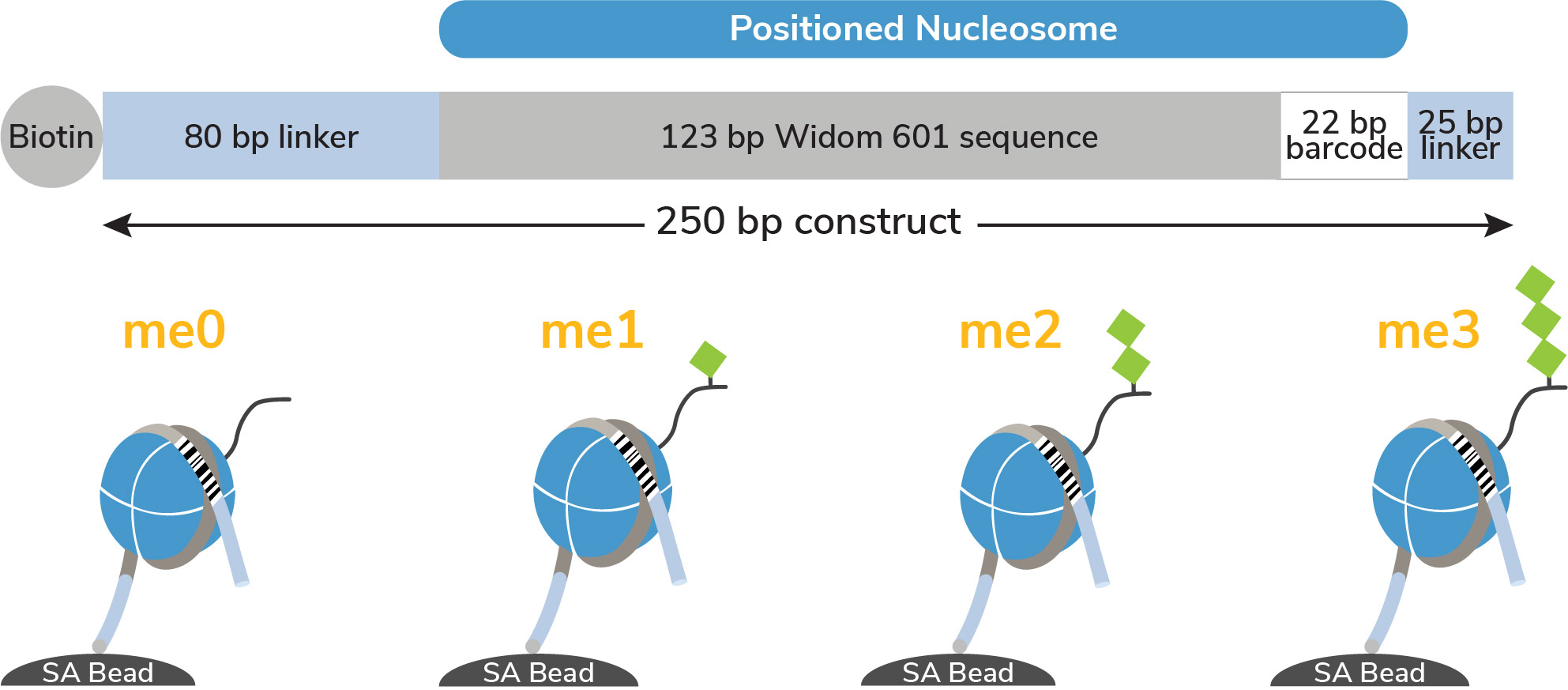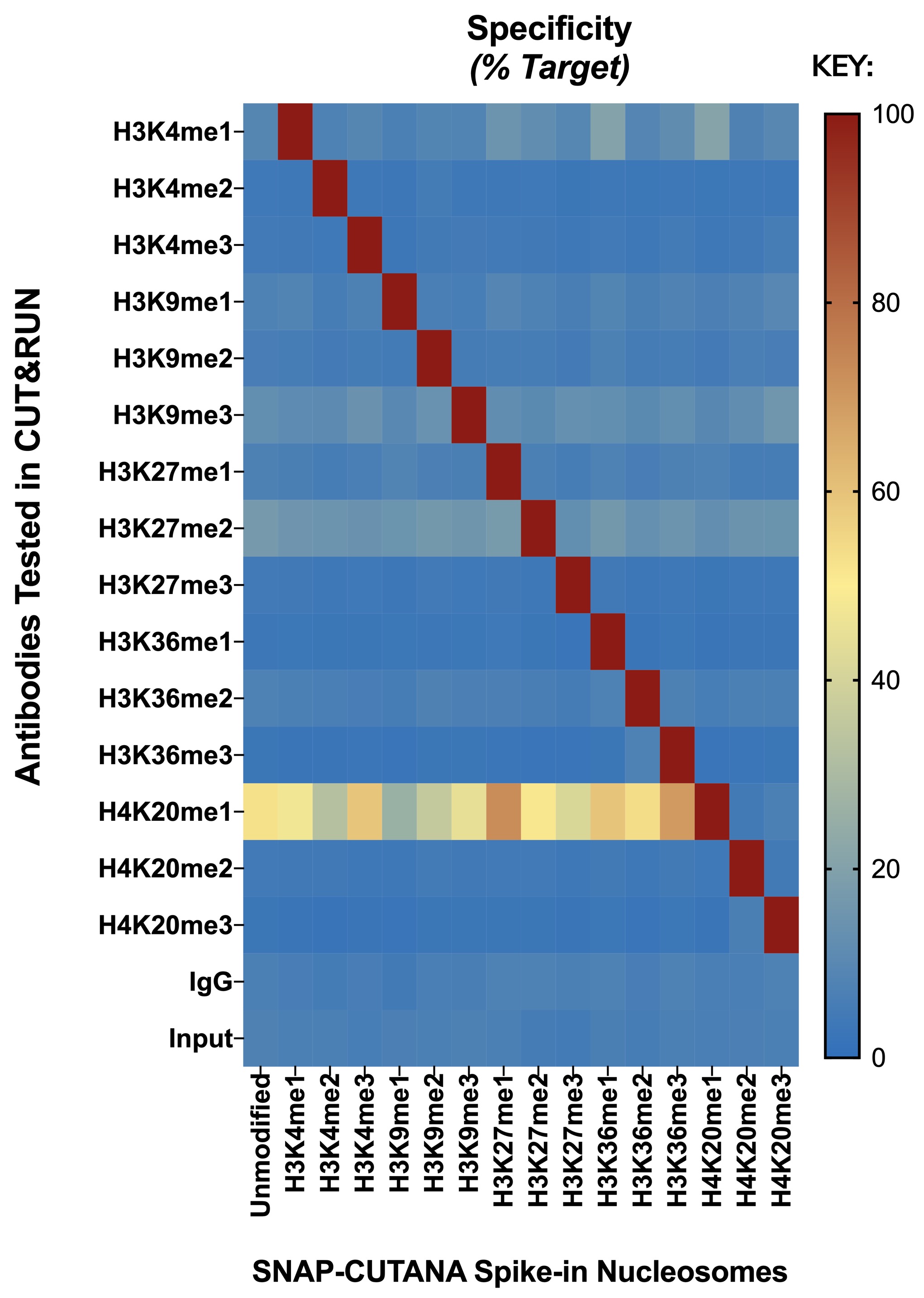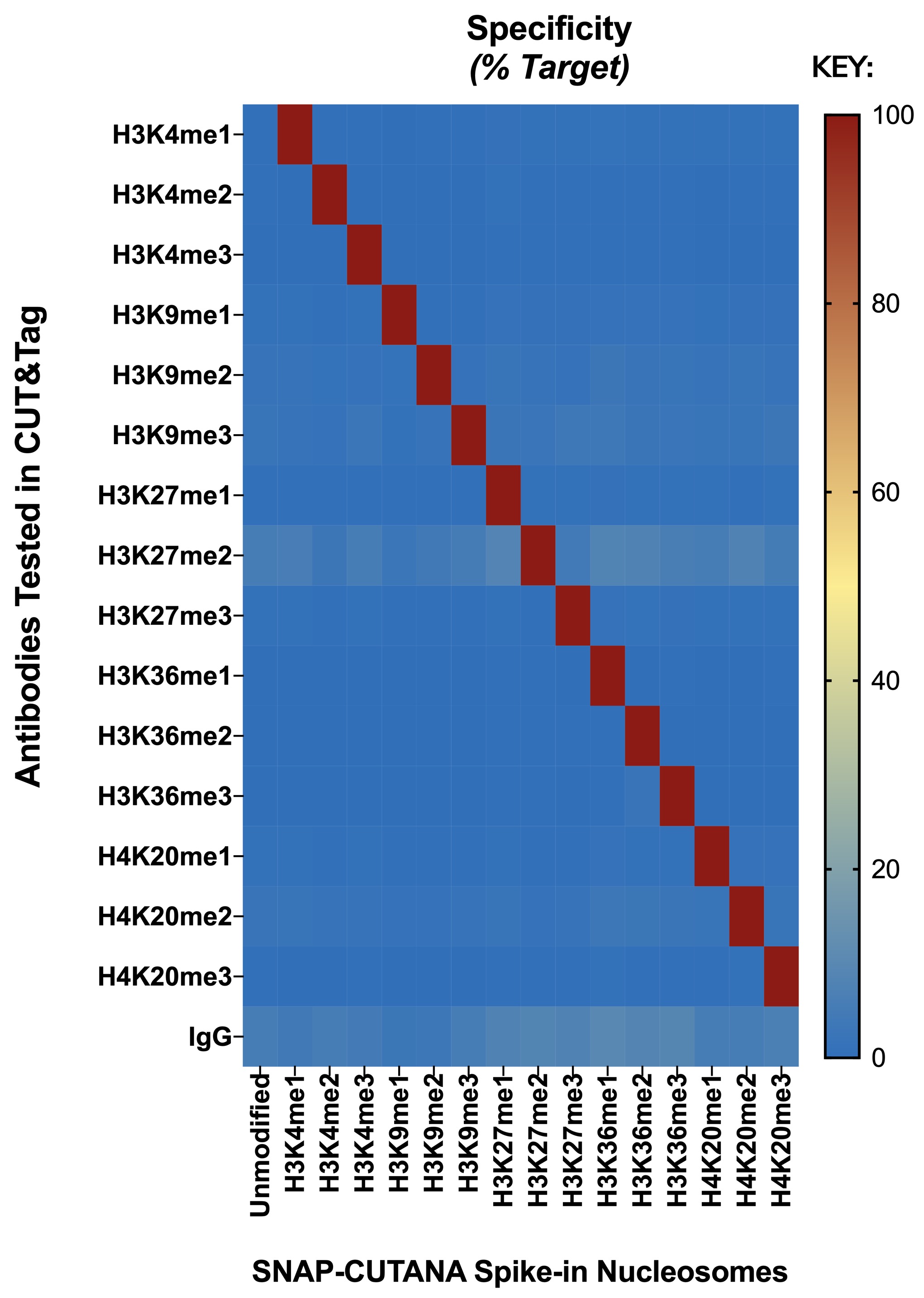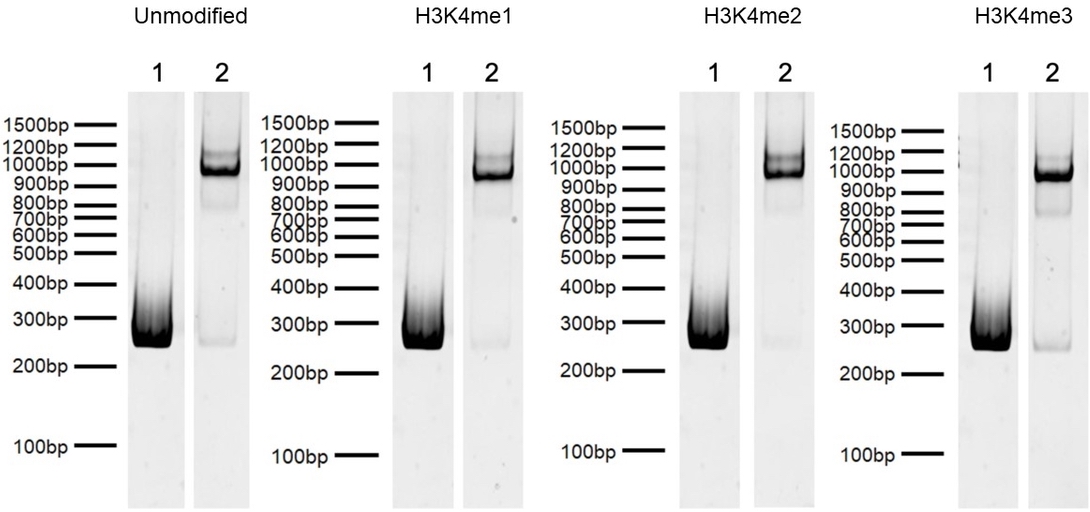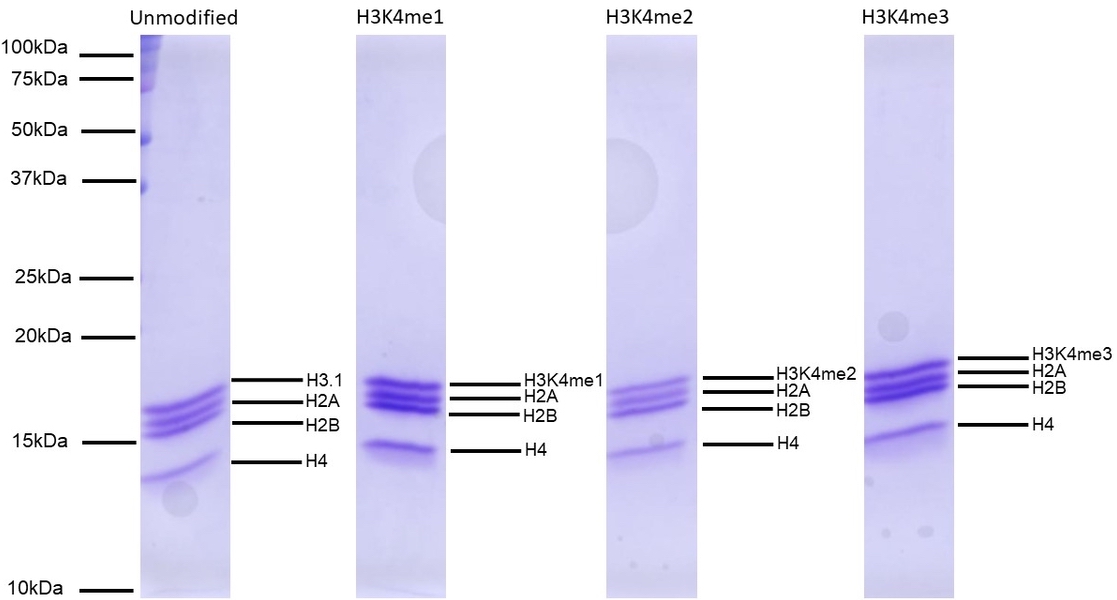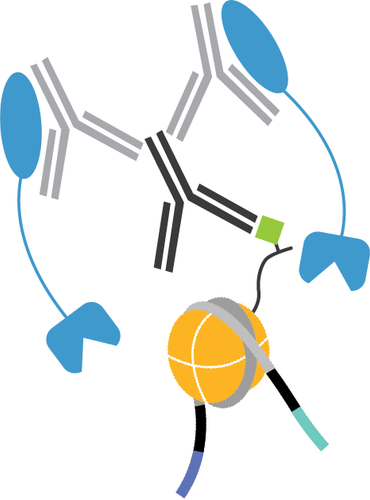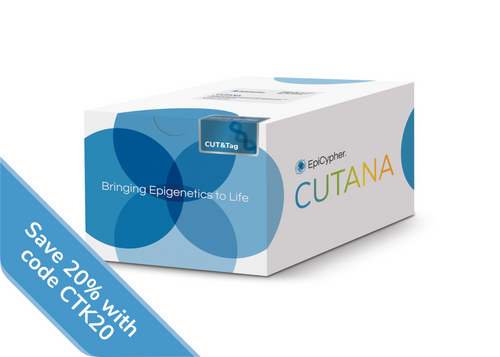

SNAP-CUTANA™ K-MetStat Panel
{"url":"https://www.epicypher.com/products/nucleosomes/snap-cutana-k-metstat-panel","add_this":[{"service":"facebook","annotation":""},{"service":"email","annotation":""},{"service":"print","annotation":""},{"service":"twitter","annotation":""},{"service":"linkedin","annotation":""}],"gtin":null,"id":883,"bulk_discount_rates":[],"can_purchase":true,"meta_description":"16 barcoded spike-in nucleosomes provide quantitative sample normalization and confirmation of K-methyl antibody specificity in CUT&RUN and CUT&Tag","category":["Nucleosomes","Epigenetics Kits and Reagents/CUTANA™ ChIC / CUT&RUN Assays","Epigenetics Kits and Reagents/CUTANA™ CUT&Tag Assays","Nucleosomes/SNAP-CUTANA™ Spike-in Controls"],"AddThisServiceButtonMeta":"","main_image":{"data":"https://cdn11.bigcommerce.com/s-y9o92/images/stencil/{:size}/products/883/911/CUTANAspike-inthumbnail_RGB_white_w_border__29403.1634679576.png?c=2","alt":"SNAP-CUTANA™ K-MetStat Panel"},"add_to_wishlist_url":"/wishlist.php?action=add&product_id=883","shipping":{"calculated":true},"num_reviews":0,"weight":"0.00 LBS","custom_fields":[{"id":"1008","name":"Pack Size","value":"50 Reactions"},{"id":"1009","name":"Internal Comment","value":"Excess in bottom shelf of Venom."}],"sku":"19-1002","description":"<div class=\"product-general-info\">\n <ul style=\"padding: 0\" class=\"product-general-info__list-right\">\n <li class=\"product-general-info__list-item\">\n <a href=\"#bioz\">\n <div\n id=\"w-s-3835-19-1002\"\n style=\"\n width: 240px;\n height: 58px;\n position: relative;\n overflow-y: hidden;\n \"\n ></div>\n <!--<div id=\"bioz-w-pb-19-1002-div\" style=\"width: 240px\">\n <a\n id=\"bioz-w-pb-19-1002\"\n style=\"font-size: 12px; color: transparent; display:none;\"\n href=\"https://www.bioz.com/\"\n target=\"_blank\"\n >\n <img\n src=\"https://cdn.bioz.com/assets/favicon.png\"\n style=\"\n width: 11px;\n height: 11px;\n vertical-align: baseline;\n padding-bottom: 0px;\n margin-left: 0px;\n margin-bottom: 0px;\n float: none;\n display: none;\n \"\n />\n Powered by Bioz\n </a>\n </div>-->\n </a>\n </li>\n </ul>\n </div>\n <div class=\"service_accordion product-droppdown\">\n <div class=\"container\">\n <div id=\"prodAccordion\">\n <div id=\"ProductDescription\" class=\"Block Panel current\">\n <h3 class=\"sub-title1\">Description</h3>\n <div\n class=\"ProductDescriptionContainer product-droppdown__section-description-specific\"\n >\n <p>\n The SNAP-CUTANA K-MetStat Panel of spike-in controls for\n CUT&RUN and CUT&Tag offers an all-in-one solution to determine\n antibody specificity for histone posttranslational\n modifications (PTMs), monitor assay success, and normalize\n data for quantitative chromatin mapping. The panel contains\n designer nucleosomes (dNucs) representing 16 different\n K-methyl PTM states: mono-, di-, and trimethylation at H3K4,\n H3K9, H3K27, H3K36, & H4K20, as well as unmodified control\n (<strong>Figure 1</strong>). Each PTM is represented by two\n unique DNA-barcoded templates (A and B, for an internal\n technical replicate). Each dNuc is individually conjugated to\n paramagnetic beads and pooled into a single panel for\n convenient one-step spike-in to CUT&RUN and CUT&Tag\n experiments. The panel is added to samples alongside\n ConA-immobilized cells prior to the addition of an antibody\n targeting a histone lysine methylation state or IgG negative\n control (see <strong>Application Notes</strong> and\n <strong>Table 1</strong>). pAG-MNase-mediated release or\n pAG-Tn5-mediated tagmentation of genomic chromatin and the\n barcoded nucleosomes is dependent on the specificity of the\n antibody used. After sequencing, the relative read count of\n each spike-in nucleosome barcode provides a quantitative\n metric of on- vs. off-target recovery (<strong\n >Figures 2 and 3</strong\n >) as well as quantitative sample normalization, thereby\n gauging experimental success, guiding troubleshooting efforts,\n and enabling reliable cross-sample comparisons.\n </p>\n <p\n style=\"\n background-color: #4698cb;\n color: #fff;\n padding: 1.3rem;\n text-align: center;\n border-radius: 12px;\n \"\n >\n <a\n target=\"_blank\"\n style=\"color: #fff; text-decoration: none\"\n href=\"/products/nucleosomes/snap-cutana-k-metstat-panel#userguide\"\n >The SNAP-CUTANA Spike-in User Guide - everything you need\n to know in one place\n </a>\n </p>\n </div>\n </div>\n </div>\n <div id=\"prodAccordion\">\n <div id=\"ProductDescription\" class=\"Block Panel current\">\n <h3 class=\"sub-title1\">Validation Data</h3>\n <div\n class=\"ProductDescriptionContainer product-droppdown__section-description-specific\"\n >\n <section class=\"image-picker\">\n <div class=\"image-picker__left\">\n <div\n class=\"image-picker__main-content_active image-picker__main-content\"\n >\n <div class=\"image-picker__header-content\">\n <button class=\"image-picker__left-arrow\">\n <svg\n class=\"image-picker__svg-left\"\n width=\"24\"\n height=\"24\"\n viewBox=\"0 0 24 24\"\n >\n <path\n d=\"M16.67 0l2.83 2.829-9.339 9.175 9.339 9.167-2.83 2.829-12.17-11.996z\"\n />\n </svg>\n </button>\n <a\n href=\"/content/images/products/nucleosomes/19-1002_graphic.jpeg\"\n target=\"_blank\"\n class=\"image-picker__main-image-link\"\n ><img\n loading=\"lazy\"\n alt=\"19-1002_graphic\"\n src=\"/content/images/products/nucleosomes/19-1002_graphic.jpeg\"\n class=\"image-picker__main-image\"\n />\n <span class=\"image-picker__main-image-caption\"\n >(Click to enlarge)</span\n ></a\n >\n <button class=\"image-picker__right-arrow\">\n <svg\n class=\"image-picker__svg-right\"\n width=\"24\"\n height=\"24\"\n viewBox=\"0 0 24 24\"\n >\n <path\n d=\"M7.33 24l-2.83-2.829 9.339-9.175-9.339-9.167 2.83-2.829 12.17 11.996z\"\n />\n </svg>\n </button>\n </div>\n <p>\n <span class=\"image-picker__span-content\"\n ><strong\n >Figure 1: Schematic of SNAP-CUTANA Spike-in\n Controls</strong\n ><br />\n The K-MetStat Panel controls for 15 widely studied\n methyl states (see Description) and an unmodified\n control (me0), with each of the 16 octamers wrapped\n with two uniquely barcoded DNA templates (A and B).\n Each 250 bp DNA template contains a 123 bp 601\n nucleosome positioning sequence (gray) [<a\n href=\"https://pubmed.ncbi.nlm.nih.gov/9514715/\"\n >Lowary & Widom, 1998</a\n >], a unique 22 bp DNA-barcode (white; 32 barcodes\n total), and a 5’ biotin-TEG. The 5’ and 3’ linkers\n (blue) are compatible with cleavage by pAG-MNase\n (EpiCypher\n <a\n href=\"https://www.epicypher.com/products/epigenetics-reagents-and-assays/cutana-chic-cut-run-kit\"\n >14-1048</a\n >,\n <a\n href=\"https://www.epicypher.com/products/epigenetics-reagents-and-assays/cutana-pag-mnase-for-chic-cut-and-run-workflows-50-rxns\"\n >15-1016</a\n >) during CUT&RUN as well as tagmentation by pAG-Tn5\n (EpiCypher\n <a\n href=\"https://www.epicypher.com/products/featured-products/cutana-pag-tn5-for-cut-tag-50-rxns\"\n >15-1017</a\n >\n ) during CUT&Tag. The dNucs are individually\n pre-conjugated to paramagnetic beads and pooled for\n convenient use.\n </span>\n </p>\n </div>\n <div class=\"image-picker__main-content\">\n <div class=\"image-picker__header-content\">\n <button class=\"image-picker__left-arrow\">\n <svg\n class=\"image-picker__svg-left\"\n width=\"24\"\n height=\"24\"\n viewBox=\"0 0 24 24\"\n >\n <path\n d=\"M16.67 0l2.83 2.829-9.339 9.175 9.339 9.167-2.83 2.829-12.17-11.996z\"\n />\n </svg>\n </button>\n <a\n href=\"/content/images/products/nucleosomes/KmetStat_Fig2_CUTRUN_Heat.jpeg\"\n target=\"_blank\"\n class=\"image-picker__main-image-link\"\n ><img\n loading=\"lazy\"\n alt=\"KmetStat_Fig2_CUTRUN_Heat\"\n src=\"/content/images/products/nucleosomes/KmetStat_Fig2_CUTRUN_Heat.jpeg\"\n class=\"image-picker__main-image\"\n />\n <span class=\"image-picker__main-image-caption\"\n >(Click to enlarge)</span\n ></a\n >\n <button class=\"image-picker__right-arrow\">\n <svg\n class=\"image-picker__svg-right\"\n width=\"24\"\n height=\"24\"\n viewBox=\"0 0 24 24\"\n >\n <path\n d=\"M7.33 24l-2.83-2.829 9.339-9.175-9.339-9.167 2.83-2.829 12.17 11.996z\"\n />\n </svg>\n </button>\n </div>\n <p>\n <span class=\"image-picker__span-content\"\n ><strong\n >Figure 2: Panel Identity Profiling by CUT&RUN </strong\n ><br />\n CUT&RUN was performed on 500k fresh K-562 cells\n utilizing best in class identified antibodies to each\n PTM represented in the SNAP-CUTANA K-MetStat Panel.\n Prior to antibody addition, 2 µL of the control panel\n was spiked into each sample. CUT&RUN sequencing reads\n were aligned to the unique DNA barcodes in the panel\n and normalized to either on-target (anti-K-methyl PTM)\n or total counts (IgG, Input). Antibody enrichment of\n the expected spike-in nucleosome target (red)\n confirmed the identity and integrity of each member of\n the panel. CUT&RUN with IgG control antibody showed no\n preferential enrichment for any particular nucleosome\n (blue), as expected. Direct sequencing of the panel\n (Input) indicated balanced pooling of each nucleosome.\n While EpiCypher has not yet identified an H4K20me1\n antibody with a preferred specificity profile in\n CUT&RUN, the clone shown has sufficient PTM preference\n to confirm the integrity of the barcoded nucleosome.\n <br />\n <br />\n <strong>Note:</strong> While most antibodies used in\n these experiments show good target specificity in our\n <strong>standard</strong> CUT&RUN / CUT&Tag\n conditions, changes to antibody lots and experimental\n variables (cell number, cell type, experimental\n treatment, salt concentration, etc.) can have adverse\n effects on antibody specificity.\n <strong\n >Single-point antibody validation under optimal\n conditions is not a suitable substitute for\n controlled experiments with spike-ins.</strong\n >\n EpiCypher recommends using SNAP spike-in controls to\n monitor experimental success and accuracy in every\n possible reaction.\n </span>\n </p>\n </div>\n <div class=\"image-picker__main-content\">\n <div class=\"image-picker__header-content\">\n <button class=\"image-picker__left-arrow\">\n <svg\n class=\"image-picker__svg-left\"\n width=\"24\"\n height=\"24\"\n viewBox=\"0 0 24 24\"\n >\n <path\n d=\"M16.67 0l2.83 2.829-9.339 9.175 9.339 9.167-2.83 2.829-12.17-11.996z\"\n />\n </svg>\n </button>\n <a\n href=\"/content/images/products/nucleosomes/19-1002_CUTTag_heat.jpeg\"\n target=\"_blank\"\n class=\"image-picker__main-image-link\"\n >\n <img\n loading=\"lazy\"\n alt=\"19-1002_CUTTag_heat\"\n src=\"/content/images/products/nucleosomes/19-1002_CUTTag_heat.jpeg\"\n class=\"image-picker__main-image\"\n />\n <span class=\"image-picker__main-image-caption\"\n >(Click to enlarge)</span\n >\n </a>\n <button class=\"image-picker__right-arrow\">\n <svg\n class=\"image-picker__svg-right\"\n width=\"24\"\n height=\"24\"\n viewBox=\"0 0 24 24\"\n >\n <path\n d=\"M7.33 24l-2.83-2.829 9.339-9.175-9.339-9.167 2.83-2.829 12.17 11.996z\"\n />\n </svg>\n </button>\n </div>\n <p>\n <span class=\"image-picker__span-content\">\n <strong\n >Figure 3: Panel Identity Profiling by\n CUT&Tag</strong\n ><br />\n CUT&Tag was performed on 100k fresh K-562 cells\n utilizing best in class identified antibodies to each\n PTM represented in the SNAP-CUTANA K-MetStat Panel.\n Prior to antibody addition, 2 µL of the control panel\n was spiked into each sample. CUT&Tag sequencing reads\n were aligned to the unique DNA barcodes in the panel\n and normalized to either on-target (anti-K-methyl PTM)\n or total counts (IgG). Antibody enrichment of the\n expected spike-in nucleosome target (red) confirmed\n the identity and integrity of each member of the\n panel. CUT&Tag with IgG control antibody showed no\n preferential enrichment for any particular nucleosome\n (blue), as expected.\n <br />\n <br />\n <strong>Note:</strong> While most antibodies used in\n these experiments show good target specificity in our\n <strong>standard</strong> CUT&RUN / CUT&Tag\n conditions, changes to antibody lots and experimental\n variables (cell number, cell type, experimental\n treatment, salt concentration, etc.) can have adverse\n effects on antibody specificity.\n <strong\n >Single-point antibody validation under optimal\n conditions is not a suitable substitute for\n controlled experiments with spike-ins.</strong\n >\n EpiCypher recommends using SNAP spike-in controls to\n monitor experimental success and accuracy in every\n possible reaction.\n </span>\n </p>\n </div>\n <div class=\"image-picker__main-content\">\n <div class=\"image-picker__header-content\">\n <button class=\"image-picker__left-arrow\">\n <svg\n class=\"image-picker__svg-left\"\n width=\"24\"\n height=\"24\"\n viewBox=\"0 0 24 24\"\n >\n <path\n d=\"M16.67 0l2.83 2.829-9.339 9.175 9.339 9.167-2.83 2.829-12.17-11.996z\"\n />\n </svg>\n </button>\n <a\n href=\"/content/images/products/nucleosomes/19-1002_Panel_Dilution.jpeg\"\n target=\"_blank\"\n class=\"image-picker__main-image-link\"\n >\n <img\n loading=\"lazy\"\n alt=\"19-1002_Panel_Dilution\"\n src=\"/content/images/products/nucleosomes/19-1002_Panel_Dilution.jpeg\"\n class=\"image-picker__main-image\"\n />\n <span class=\"image-picker__main-image-caption\"\n >(Click to enlarge)</span\n >\n </a>\n <button class=\"image-picker__right-arrow\">\n <svg\n class=\"image-picker__svg-right\"\n width=\"24\"\n height=\"24\"\n viewBox=\"0 0 24 24\"\n >\n <path\n d=\"M7.33 24l-2.83-2.829 9.339-9.175-9.339-9.167 2.83-2.829 12.17 11.996z\"\n />\n </svg>\n </button>\n </div>\n <p>\n <span class=\"image-picker__span-content\">\n <strong\n >Table 1: Recommended SNAP-CUTANA Spike-In Dilution\n for CUT&RUN / CUT&Tag Samples of Varying Starting\n Cell Number</strong\n ><br />\n </span>\n </p>\n </div>\n <div class=\"image-picker__main-content\">\n <div class=\"image-picker__header-content\">\n <button class=\"image-picker__left-arrow\">\n <svg\n class=\"image-picker__svg-left\"\n width=\"24\"\n height=\"24\"\n viewBox=\"0 0 24 24\"\n >\n <path\n d=\"M16.67 0l2.83 2.829-9.339 9.175 9.339 9.167-2.83 2.829-12.17-11.996z\"\n />\n </svg>\n </button>\n <a\n href=\"/content/images/products/nucleosomes/19-1002_Native_TDS.jpeg\"\n target=\"_blank\"\n class=\"image-picker__main-image-link\"\n >\n <img\n loading=\"lazy\"\n alt=\"19-1002_Native_TDS\"\n src=\"/content/images/products/nucleosomes/19-1002_Native_TDS.jpeg\"\n class=\"image-picker__main-image\"\n />\n <span class=\"image-picker__main-image-caption\"\n >(Click to enlarge)</span\n >\n </a>\n <button class=\"image-picker__right-arrow\">\n <svg\n class=\"image-picker__svg-right\"\n width=\"24\"\n height=\"24\"\n viewBox=\"0 0 24 24\"\n >\n <path\n d=\"M7.33 24l-2.83-2.829 9.339-9.175-9.339-9.167 2.83-2.829 12.17 11.996z\"\n />\n </svg>\n </button>\n </div>\n <p>\n <span class=\"image-picker__span-content\">\n <strong>Figure 4: DNA Gel Data</strong><br />\n Representative images for SNAP-CUTANA K-MetStat\n nucleosomes resolved by native PAGE and stained with\n ethidium bromide to confirm intact nucleosome assembly\n with minimal free DNA. Lane 1: Free 250 bp DNA used in\n nucleosome assembly (100 ng). Lane 2: Intact\n nucleosomes (400 ng). Comparable experiments were\n performed for the entire SNAP-CUTANA K-MetStat Panel.\n </span>\n </p>\n </div>\n <div class=\"image-picker__main-content\">\n <div class=\"image-picker__header-content\">\n <button class=\"image-picker__left-arrow\">\n <svg\n class=\"image-picker__svg-left\"\n width=\"24\"\n height=\"24\"\n viewBox=\"0 0 24 24\"\n >\n <path\n d=\"M16.67 0l2.83 2.829-9.339 9.175 9.339 9.167-2.83 2.829-12.17-11.996z\"\n />\n </svg>\n </button>\n <a\n href=\"/content/images/products/nucleosomes/19-1002_Octamer_TDS.jpeg\"\n target=\"_blank\"\n class=\"image-picker__main-image-link\"\n >\n <img\n loading=\"lazy\"\n alt=\"19-1002_Octamer_TDS\"\n src=\"/content/images/products/nucleosomes/19-1002_Octamer_TDS.jpeg\"\n class=\"image-picker__main-image\"\n />\n <span class=\"image-picker__main-image-caption\"\n >(Click to enlarge)</span\n >\n </a>\n <button class=\"image-picker__right-arrow\">\n <svg\n class=\"image-picker__svg-right\"\n width=\"24\"\n height=\"24\"\n viewBox=\"0 0 24 24\"\n >\n <path\n d=\"M7.33 24l-2.83-2.829 9.339-9.175-9.339-9.167 2.83-2.829 12.17 11.996z\"\n />\n </svg>\n </button>\n </div>\n <p>\n <span class=\"image-picker__span-content\">\n <strong>Figure 5: Protein Gel Data</strong><br />\n Representative Coomassie stained PAGE of SNAP-CUTANA\n K-MetStat dNucs (1 µg each) demonstrates the purity of\n histones in the preparation. Sizes of molecular weight\n markers and positions of the core histones (H2A, H2B,\n H3 and H4) are indicated. Comparable experiments were\n performed for the entire SNAP-CUTANA K-MetStat Panel.\n </span>\n </p>\n </div>\n </div>\n <aside class=\"image-picker__right\">\n <div class=\"image-picker__gallery\">\n <img\n loading=\"lazy\"\n alt=\"19-1002_graphic\"\n src=\"/content/images/products/nucleosomes/19-1002_graphic.jpeg\"\n width=\"200\"\n class=\"image-picker__side-image image-picker__side-image_active\"\n role=\"button\"\n />\n <img\n loading=\"lazy\"\n alt=\"KmetStat_Fig2_CUTRUN_Heat\"\n src=\"/content/images/products/nucleosomes/KmetStat_Fig2_CUTRUN_Heat.jpeg\"\n class=\"image-picker__side-image\"\n role=\"button\"\n />\n <img\n loading=\"lazy\"\n alt=\"19-1002_CUTTag_heat\"\n src=\"/content/images/products/nucleosomes/19-1002_CUTTag_heat.jpeg\"\n class=\"image-picker__side-image\"\n role=\"button\"\n />\n <img\n loading=\"lazy\"\n alt=\"19-1002_Panel_Dilution\"\n src=\"/content/images/products/nucleosomes/19-1002_Panel_Dilution.jpeg\"\n class=\"image-picker__side-image\"\n role=\"button\"\n />\n <img\n loading=\"lazy\"\n alt=\"19-1002_Native_TDS\"\n src=\"/content/images/products/nucleosomes/19-1002_Native_TDS.jpeg\"\n class=\"image-picker__side-image\"\n role=\"button\"\n />\n <img\n loading=\"lazy\"\n alt=\"19-1002_Octamer_TDS\"\n src=\"/content/images/products/nucleosomes/19-1002_Octamer_TDS.jpeg\"\n class=\"image-picker__side-image\"\n role=\"button\"\n />\n </div>\n </aside>\n </section>\n </div>\n </div>\n </div>\n <div id=\"userguide\"></div>\n <div id=\"prodAccordion\">\n <div id=\"ProductDescription\" class=\"Block Panel\">\n <h3 class=\"sub-title1\">Technical Information</h3>\n <div\n class=\"ProductDescriptionContainer product-droppdown__section-description\"\n >\n <div class=\"product-tech-info\">\n <div class=\"product-tech-info__line-item\">\n <div class=\"product-tech-info__line-item-left\">\n <b>Storage</b>\n </div>\n <div class=\"product-tech-info__line-item-right\">\n Store at -20°C.\n <strong\n >Lower temperatures can cause freezing and will\n permanently damage the magnetic beads</strong\n >. Stable for six months from date of receipt.<br />Pipette\n to resuspend beads; <strong>DO NOT VORTEX</strong>\n </div>\n </div>\n <div class=\"product-tech-info__line-item\">\n <div class=\"product-tech-info__line-item-left\">\n <b>Formulation</b>\n </div>\n <div class=\"product-tech-info__line-item-right\">\n A mixture of 16 PTM-defined semi-synthetic nucleosomes conjugated to paramagnetic beads in 10 mM sodium cacodylate pH 7.5, 100 mM NaCl, 1 mM EDTA, 50% glycerol (w/v), 1x Protease Inhibitor Cocktail, 100 μg/mL BSA, 10 mM β-mercaptoethanol Molarity = 0.6 nM per nucleosome, 9.6 nM total nucleosome.\n </div>\n </div>\n </div>\n </div>\n </div>\n </div>\n <div id=\"prodAccordion\">\n <div id=\"ProductDescription\" class=\"Block Panel\">\n <h3 class=\"sub-title1\">Application Notes</h3>\n <div\n class=\"ProductDescriptionContainer product-droppdown__section-description\"\n >\n <p>\n <em\n >See the most recent\n <a href=\"/resources/protocols\"\n >EpiCypher CUT&RUN or CUT&Tag protocols</a\n >\n for detailed information on workflow integration, expected\n results, data analysis, and troubleshooting. In Brief:</em\n >\n </p>\n <p>\n <u><strong>Product Use:</strong></u> Use the SNAP-CUTANA\n K-MetStat Panel for control reactions containing positive\n (e.g.\n <a\n href=\"/products/antibodies/snap-chip-certified-antibodies/histone-h3k4me3-antibody-snap-chip-certified-cutana-cut-run-compatible\"\n >H3K4me3</a\n >) and negative (<a\n href=\"/products/epigenetics-reagents-and-assays/cutana-chic-cut-run-assays/cutana-rabbit-igg-cut-run-negative-control-antibody\"\n >IgG</a\n >) antibodies, as well as samples with an antibody to any of\n the 15 lysine methyl states in the K-MetStat Panel. Just\n before antibody addition, spike in 2 μL per 500k cells for\n CUT&RUN and 2 μL per 100k cells for CUT&Tag. If using less\n than the standard number of cells, decrease the amount of\n SNAP-CUTANA spike-in linearly by preparing a “working stock”\n dilution of the panel in the appropriate buffer, made fresh\n the day of use (<strong>Table 1</strong>). Adjust spike-in\n volume as needed; aiming for the spike-ins to comprise ~1% of\n the total sequencing reads. Expect higher for low abundance\n targets / negative controls (IgG; ~10-20%) and lower for high\n abundance targets (H3K27me3; 0.1-1%).\n <strong>Table 1</strong> gives recommended dilution amounts\n for varying numbers of starting cells, but optimization may be\n required for user-specific conditions.\n </p>\n\n <p>\n <u><strong>Data Analysis:</strong></u> Perform paired end\n sequencing for a minimum of 50 bases. The Widom 601 DNA and\n DNA barcodes are distinct from human, mouse, fly, and yeast\n genomes such that they can be readily distinguished from\n sample chromatin. A shell script (.sh file extension) for\n spike-in alignment and an excel template for heatmap\n generation are available in the\n <strong>Documents & Resources</strong>\n section below. The shell script can be opened with any basic\n text editor program and contains detailed instructions hashed\n (#) at the beginning of the document. Make sure to copy and\n paste the R1 & R2 echo loop so there is a set for each sample\n being analyzed.\n </p>\n </div>\n </div>\n </div>\n <div id=\"prodAccordion\">\n <div id=\"ProductDescription\" class=\"Block Panel current\">\n <h3 class=\"sub-title1\">Documents & Resources</h3>\n\n <div\n class=\"ProductDescriptionContainer product-droppdown__section-description-specific\"\n >\n <div class=\"product-documents\">\n <a\n href=\"/content/documents/tds/19-1002.pdf\"\n target=\"_blank\"\n class=\"product-documents__link\"\n >\n <svg\n version=\"1.1\"\n id=\"Layer_1\"\n xmlns=\"http://www.w3.org/2000/svg\"\n xmlns:xlink=\"http://www.w3.org/1999/xlink\"\n x=\"0px\"\n y=\"0px\"\n viewBox=\"0 0 228 240\"\n style=\"enable-background: new 0 0 228 240\"\n xml:space=\"preserve\"\n class=\"product-documents__icon\"\n alt=\"16-0030 Datasheet\"\n >\n <g>\n <path\n class=\"product-documents__svg-pdf\"\n d=\"M191.92,68.77l-47.69-47.69c-1.33-1.33-3.12-2.08-5.01-2.08H45.09C41.17,19,38,22.17,38,26.09v184.36\n c0,3.92,3.17,7.09,7.09,7.09h141.82c3.92,0,7.09-3.17,7.09-7.09V73.8C194,71.92,193.25,70.1,191.92,68.77z M177.65,77.06h-41.7\n v-41.7L177.65,77.06z M178.05,201.59H53.95V34.95h66.92v47.86c0,5.14,4.17,9.31,9.31,9.31h47.86V201.59z\"\n />\n </g>\n <rect\n x=\"20\"\n y=\"112\"\n class=\"product-documents__svg-background\"\n width=\"146\"\n height=\"76\"\n />\n <g>\n <path\n class=\"product-documents__svg-pdf\"\n d=\"M23.83,125.68h22.36c5.29,0,9.41,1.33,12.35,4c2.94,2.67,4.42,6.39,4.42,11.18c0,4.78-1.47,8.51-4.42,11.18\n c-2.94,2.67-7.06,4-12.35,4H34.59v18.29H23.83V125.68z M44.81,147.9c5.38,0,8.07-2.32,8.07-6.97c0-2.39-0.67-4.16-2-5.31\n c-1.33-1.15-3.36-1.73-6.07-1.73H34.59v14.01H44.81z\"\n />\n <path\n class=\"product-documents__svg-pdf\"\n d=\"M69.92,125.68h18.91c5.29,0,9.84,0.97,13.66,2.9c3.82,1.93,6.74,4.72,8.76,8.35\n c2.02,3.63,3.04,7.98,3.04,13.04c0,5.06-1,9.42-3,13.08c-2,3.66-4.91,6.45-8.73,8.38c-3.82,1.93-8.4,2.9-13.73,2.9H69.92V125.68z\n M88.07,165.63c10.35,0,15.52-5.22,15.52-15.66c0-10.4-5.17-15.59-15.52-15.59h-7.38v31.26H88.07z\"\n />\n <path\n class=\"product-documents__svg-pdf\"\n d=\"M122.57,125.68h32.84v8.49h-22.22v11.18h20.84v8.49h-20.84v20.49h-10.63V125.68z\"\n />\n </g>\n </svg>\n <span class=\"product-documents__info\"\n >Technical Datasheet</span\n >\n </a>\n </div>\n <div class=\"product-documents\">\n <div style=\"display: flex\">\n <a\n href=\"/content/documents/SNAP-CUTANA_K-MetStat_user_guide.pdf\"\n target=\"_blank\"\n class=\"product-documents__link\"\n >\n <svg\n version=\"1.1\"\n id=\"Layer_1\"\n xmlns=\"http://www.w3.org/2000/svg\"\n xmlns:xlink=\"http://www.w3.org/1999/xlink\"\n x=\"0px\"\n y=\"0px\"\n viewBox=\"0 0 228 240\"\n style=\"enable-background: new 0 0 228 240\"\n xml:space=\"preserve\"\n class=\"product-documents__icon\"\n alt=\"16-0030 Datasheet\"\n >\n <g>\n <path\n class=\"product-documents__svg-pdf\"\n d=\"M191.92,68.77l-47.69-47.69c-1.33-1.33-3.12-2.08-5.01-2.08H45.09C41.17,19,38,22.17,38,26.09v184.36\n c0,3.92,3.17,7.09,7.09,7.09h141.82c3.92,0,7.09-3.17,7.09-7.09V73.8C194,71.92,193.25,70.1,191.92,68.77z M177.65,77.06h-41.7\n v-41.7L177.65,77.06z M178.05,201.59H53.95V34.95h66.92v47.86c0,5.14,4.17,9.31,9.31,9.31h47.86V201.59z\"\n />\n </g>\n <rect\n x=\"20\"\n y=\"112\"\n class=\"product-documents__svg-background\"\n width=\"146\"\n height=\"76\"\n />\n <g>\n <path\n class=\"product-documents__svg-pdf\"\n d=\"M23.83,125.68h22.36c5.29,0,9.41,1.33,12.35,4c2.94,2.67,4.42,6.39,4.42,11.18c0,4.78-1.47,8.51-4.42,11.18\n c-2.94,2.67-7.06,4-12.35,4H34.59v18.29H23.83V125.68z M44.81,147.9c5.38,0,8.07-2.32,8.07-6.97c0-2.39-0.67-4.16-2-5.31\n c-1.33-1.15-3.36-1.73-6.07-1.73H34.59v14.01H44.81z\"\n />\n <path\n class=\"product-documents__svg-pdf\"\n d=\"M69.92,125.68h18.91c5.29,0,9.84,0.97,13.66,2.9c3.82,1.93,6.74,4.72,8.76,8.35\n c2.02,3.63,3.04,7.98,3.04,13.04c0,5.06-1,9.42-3,13.08c-2,3.66-4.91,6.45-8.73,8.38c-3.82,1.93-8.4,2.9-13.73,2.9H69.92V125.68z\n M88.07,165.63c10.35,0,15.52-5.22,15.52-15.66c0-10.4-5.17-15.59-15.52-15.59h-7.38v31.26H88.07z\"\n />\n <path\n class=\"product-documents__svg-pdf\"\n d=\"M122.57,125.68h32.84v8.49h-22.22v11.18h20.84v8.49h-20.84v20.49h-10.63V125.68z\"\n />\n </g>\n </svg>\n </a>\n <a\n class=\"product-documents__link\"\n href=\"/content/documents/SNAP-CUTANA_K-MetStat_user_guide.pdf\"\n ><span class=\"product-documents__info\" s\n >SNAP-CUTANA™ Spike-in User Guide for CUT&RUN and\n CUT&Tag</span\n >\n </a>\n </div>\n </div>\n <div class=\"product-documents\">\n <a\n href=\"/content/documents/SNAP-CUTANA_K-MetStat_Panel_ShellScript.sh\"\n target=\"_blank\"\n class=\"product-documents__link\"\n >\n <svg\n version=\"1.1\"\n id=\"Layer_1\"\n xmlns=\"http://www.w3.org/2000/svg\"\n xmlns:xlink=\"http://www.w3.org/1999/xlink\"\n x=\"0px\"\n y=\"0px\"\n viewBox=\"0 0 228 240\"\n style=\"enable-background: new 0 0 228 240\"\n xml:space=\"preserve\"\n class=\"product-documents__icon\"\n >\n <g>\n <path\n class=\"product-documents__svg-txt\"\n d=\"M199.12,66.39l-51.16-51.16c-1.43-1.43-3.35-2.23-5.37-2.23H41.61c-4.2,0-7.61,3.41-7.61,7.61v197.79\n c0,4.2,3.41,7.61,7.61,7.61h152.14c4.2,0,7.61-3.41,7.61-7.61V71.79C201.36,69.77,200.55,67.82,199.12,66.39L199.12,66.39z\n M183.81,75.28h-44.74V30.54L183.81,75.28z M184.24,208.88H51.12V30.12h71.79v51.35c0,5.51,4.47,9.98,9.98,9.98h51.35V208.88z\n M115.78,144.7H72.04c-1.05,0-1.9,0.86-1.9,1.9v11.41c0,1.05,0.86,1.9,1.9,1.9h43.74c1.05,0,1.9-0.86,1.9-1.9V146.6\n C117.68,145.55,116.82,144.7,115.78,144.7z M70.13,114.27v11.41c0,1.05,0.86,1.9,1.9,1.9h91.29c1.05,0,1.9-0.86,1.9-1.9v-11.41\n c0-1.05-0.86-1.9-1.9-1.9H72.04C70.99,112.37,70.13,113.22,70.13,114.27z\"\n />\n </g>\n </svg>\n <span class=\"product-documents__info\">\n SNAP-CUTANA™ K-MetStat Panel Shell Script</span\n >\n </a>\n </div>\n <div class=\"product-documents\">\n <a\n href=\"/content/documents/SNAP-CUTANA_K-MetStat_Panel_Analysis.xlsx\"\n target=\"_blank\"\n class=\"product-documents__link\"\n >\n <svg\n version=\"1.1\"\n id=\"Layer_1\"\n xmlns=\"http://www.w3.org/2000/svg\"\n xmlns:xlink=\"http://www.w3.org/1999/xlink\"\n x=\"0px\"\n y=\"0px\"\n viewBox=\"0 0 228 240\"\n style=\"enable-background: new 0 0 228 240\"\n xml:space=\"preserve\"\n class=\"product-documents__icon\"\n >\n <g>\n <path\n class=\"product-documents__svg-excel\"\n d=\"M193.17,69.88l-46.83-46.83c-1.31-1.31-3.07-2.05-4.92-2.05H48.96C45.11,21,42,24.11,42,27.96v181.07\n c0,3.85,3.11,6.96,6.96,6.96h139.29c3.85,0,6.96-3.11,6.96-6.96V74.82C195.21,72.97,194.47,71.19,193.17,69.88L193.17,69.88z\n M179.15,78.02h-40.96V37.06L179.15,78.02z M179.54,200.33H57.67V36.67h65.73v47.01c0,5.05,4.09,9.14,9.14,9.14h47.01V200.33z\n M119.06,133.32l-13.45-22.29c-0.48-0.78-2.24-1.24-2.24-1.24h-8.33c-0.5,0-0.98,0.13-1.39,0.41c-1.21,0.76-1.58,2.36-0.8,3.6\n l17.85,28.28l-18.08,28.8c-0.76,1.22-0.39,2.83,0.84,3.6c0.41,0.26,0.89,0.39,1.37,0.39h7.48c0,0,1.74-0.26,2.22-1.02l13.65-22.09\n l13.56,22.07c0.48,0.78,2.22,1.26,2.22,1.26h8.18c0.5,0,0.98-0.15,1.42-0.42c1.22-0.79,1.57-2.4,0.79-3.63l-18.35-28.48\n l18.63-28.94c0.78-1.23,0.42-2.85-0.81-3.63c-0.42-0.27-0.9-0.41-1.4-0.41h-7.79c0,0-1.76,0.7-2.24,1.48L119.06,133.32z\"\n />\n </g>\n </svg>\n <span class=\"product-documents__info\"\n >SNAP-CUTANA™ K-MetStat Panel Analysis</span\n >\n </a>\n </div>\n </div>\n </div>\n </div>\n <div id=\"prodAccordion\">\n <div id=\"ProductDescription\" class=\"Block Panel current\">\n <h3\n id=\"bioz\"\n class=\"sub-title1\"\n >\n Product References\n </h3>\n\n <div\n class=\"ProductDescriptionContainer product-droppdown__section-description-specific\"\n >\n <object\n id=\"wobj-3835-19-1002-q\"\n type=\"text/html\"\n data=\"https://www.bioz.com/v_widget_6_0/3835/19-1002/\"\n style=\"width: 100%; height: 193px\"\n ></object>\n <div id=\"bioz-w-pb-3835-19-1002-q-div\" style=\"width: 100%\">\n <a\n id=\"bioz-w-pb-3835-19-1002-q\"\n style=\"\n font-size: 12px;\n text-decoration: none;\n color: #4698cb;\n \"\n href=\"https://www.bioz.com/\"\n target=\"_blank\"\n ><img\n src=\"https://cdn.bioz.com/assets/favicon.png\"\n style=\"\n width: 11px;\n height: 11px;\n vertical-align: baseline;\n padding-bottom: 0px;\n margin-left: 0px;\n margin-bottom: 0px;\n float: none;\n \"\n />\n Powered by Bioz</a\n >\n <a\n style=\"\n font-size: 12px;\n text-decoration: none;\n float: right;\n color: transparent;\n \"\n href=\"https://www.bioz.com/result/19-1002/product/EpiCypher/?cn=19-1002\"\n target=\"_blank\"\n >\n See more details on Bioz</a\n >\n </div>\n </div>\n </div>\n </div>\n </div>\n </div>\n <script>\n $(document).ready(function () {\n var widget_micro_obj = new v_widget_obj(\"s\", [1]);\n widget_micro_obj.request_catalog_number_widget_data_internal(\n \"19-1002\",\n \"19-1002\"\n );\n });\n </script>\n <style>\n .bioz-w-header td {\n padding: 0;\n }\n td table {\n margin: 0;\n padding: 6px !important;\n }\n </style>","tags":[],"warranty":"","price":{"without_tax":{"formatted":"$295.00","value":295,"currency":"USD"},"tax_label":"Sales Tax"},"detail_messages":"","availability":"","page_title":"SNAP-CUTANA K-MetStat Spike-In Control for CUT&RUN / CUT&Tag","cart_url":"https://www.epicypher.com/cart.php","max_purchase_quantity":0,"mpn":null,"upc":null,"options":[],"related_products":[{"id":986,"sku":null,"name":"CUTANA™ CUT&Tag Kit","url":"https://www.epicypher.com/products/epigenetics-kits-and-reagents/cutana-cut-and-tag-kit","availability":"","rating":null,"brand":{"name":null},"category":["Antibodies/CUTANA™ CUT&Tag Antibodies","Epigenetics Kits and Reagents/CUTANA™ CUT&Tag Assays"],"summary":"\n \n \n \n \n ","image":{"data":"https://cdn11.bigcommerce.com/s-y9o92/images/stencil/{:size}/products/986/1213/CTK20__46720.1713641110.png?c=2","alt":"CUTANA™ CUT&Tag Kit"},"images":[{"data":"https://cdn11.bigcommerce.com/s-y9o92/images/stencil/{:size}/products/986/1213/CTK20__46720.1713641110.png?c=2","alt":"CUTANA™ CUT&Tag Kit"}],"date_added":"8th Mar 2023","pre_order":false,"show_cart_action":true,"has_options":true,"stock_level":null,"low_stock_level":null,"qty_in_cart":0,"custom_fields":[{"id":1219,"name":"Pack Size","value":"48 Reactions"}],"num_reviews":null,"weight":{"formatted":"0.01 LBS","value":0.01},"demo":false,"price":{"without_tax":{"currency":"USD","formatted":"$2,695.00","value":2695},"tax_label":"Sales Tax"},"add_to_wishlist_url":"/wishlist.php?action=add&product_id=986"},{"id":694,"sku":null,"name":"CUTANA™ pAG-MNase for ChIC/CUT&RUN Workflows","url":"https://www.epicypher.com/products/epigenetics-reagents-and-assays/cutana-pag-mnase-for-chic-cut-and-run-workflows","availability":"","rating":null,"brand":{"name":null},"category":["Epigenetics Kits and Reagents","Epigenetics Kits and Reagents/CUTANA™ ChIC / CUT&RUN Assays"],"summary":"\n \n \n Type: Nuclease\n \n \n Mol Wgt: 43.7 kDa\n \n \n \n ","image":{"data":"https://cdn11.bigcommerce.com/s-y9o92/images/stencil/{:size}/products/694/689/Screen_Shot_2020-02-12_at_11.01.55_AM__17144.1581530752.png?c=2","alt":"CUTANA™ pAG-MNase for ChIC/CUT&RUN Workflows"},"images":[{"data":"https://cdn11.bigcommerce.com/s-y9o92/images/stencil/{:size}/products/694/689/Screen_Shot_2020-02-12_at_11.01.55_AM__17144.1581530752.png?c=2","alt":"CUTANA™ pAG-MNase for ChIC/CUT&RUN Workflows"}],"date_added":"12th Aug 2019","pre_order":false,"show_cart_action":true,"has_options":true,"stock_level":null,"low_stock_level":null,"qty_in_cart":0,"custom_fields":[{"id":1174,"name":"Internal Comment","value":"Excess in bottom of Venom"},{"id":1175,"name":"Internal Comment","value":"Bulk in Psylocke"}],"num_reviews":null,"weight":{"formatted":"0.01 LBS","value":0.01},"demo":false,"price":{"without_tax":{"currency":"USD","formatted":"$335.00","value":335},"price_range":{"min":{"without_tax":{"currency":"USD","formatted":"$335.00","value":335},"tax_label":"Sales Tax"},"max":{"without_tax":{"currency":"USD","formatted":"$1,295.00","value":1295},"tax_label":"Sales Tax"}},"tax_label":"Sales Tax"},"add_to_wishlist_url":"/wishlist.php?action=add&product_id=694"},{"id":764,"sku":null,"name":"CUTANA™ pAG-Tn5 for CUT&Tag","url":"https://www.epicypher.com/products/epigenetics-kits-and-reagents/cutana-pag-tn5-for-cut-and-tag","availability":"","rating":null,"brand":{"name":null},"category":["Epigenetics Kits and Reagents","Epigenetics Kits and Reagents/CUTANA™ CUT&Tag Assays"],"summary":"\n \n \n Type: Transposase\n \n \n Mol Wgt: 191 kDa\n \n \n \n ","image":{"data":"https://cdn11.bigcommerce.com/s-y9o92/images/stencil/{:size}/products/764/750/2020_CUTTag_icon_RGB_Andy_L__93238.1592491196.png?c=2","alt":"CUTANA™ pAG-Tn5 for CUT&Tag"},"images":[{"data":"https://cdn11.bigcommerce.com/s-y9o92/images/stencil/{:size}/products/764/750/2020_CUTTag_icon_RGB_Andy_L__93238.1592491196.png?c=2","alt":"CUTANA™ pAG-Tn5 for CUT&Tag"}],"date_added":"17th Jun 2020","pre_order":false,"show_cart_action":true,"has_options":true,"stock_level":null,"low_stock_level":null,"qty_in_cart":0,"custom_fields":[{"id":1005,"name":"Internal Comment","value":"extra boxes in bottom shelf of Venom"}],"num_reviews":null,"weight":{"formatted":"0.01 LBS","value":0.01},"demo":false,"price":{"without_tax":{"currency":"USD","formatted":"$795.00","value":795},"price_range":{"min":{"without_tax":{"currency":"USD","formatted":"$795.00","value":795},"tax_label":"Sales Tax"},"max":{"without_tax":{"currency":"USD","formatted":"$2,995.00","value":2995},"tax_label":"Sales Tax"}},"tax_label":"Sales Tax"},"add_to_wishlist_url":"/wishlist.php?action=add&product_id=764"}],"shipping_messages":[],"rating":0,"meta_keywords":"CUT&RUN controls, CUT&Tag controls, CUT&RUN antibody, CUT&Tag antibody, genomic mapping normalization, sample normalization, antibody specificity, ","show_quantity_input":1,"title":"SNAP-CUTANA™ K-MetStat Panel","gift_wrapping_available":false,"min_purchase_quantity":0,"customizations":[],"images":[{"data":"https://cdn11.bigcommerce.com/s-y9o92/images/stencil/{:size}/products/883/911/CUTANAspike-inthumbnail_RGB_white_w_border__29403.1634679576.png?c=2","alt":"SNAP-CUTANA™ K-MetStat Panel"}]} Pack Size: 50 Reactions
Description
The SNAP-CUTANA K-MetStat Panel of spike-in controls for CUT&RUN and CUT&Tag offers an all-in-one solution to determine antibody specificity for histone posttranslational modifications (PTMs), monitor assay success, and normalize data for quantitative chromatin mapping. The panel contains designer nucleosomes (dNucs) representing 16 different K-methyl PTM states: mono-, di-, and trimethylation at H3K4, H3K9, H3K27, H3K36, & H4K20, as well as unmodified control (Figure 1). Each PTM is represented by two unique DNA-barcoded templates (A and B, for an internal technical replicate). Each dNuc is individually conjugated to paramagnetic beads and pooled into a single panel for convenient one-step spike-in to CUT&RUN and CUT&Tag experiments. The panel is added to samples alongside ConA-immobilized cells prior to the addition of an antibody targeting a histone lysine methylation state or IgG negative control (see Application Notes and Table 1). pAG-MNase-mediated release or pAG-Tn5-mediated tagmentation of genomic chromatin and the barcoded nucleosomes is dependent on the specificity of the antibody used. After sequencing, the relative read count of each spike-in nucleosome barcode provides a quantitative metric of on- vs. off-target recovery (Figures 2 and 3) as well as quantitative sample normalization, thereby gauging experimental success, guiding troubleshooting efforts, and enabling reliable cross-sample comparisons.
The SNAP-CUTANA Spike-in User Guide - everything you need to know in one place
Validation Data
Figure 1: Schematic of SNAP-CUTANA Spike-in
Controls
The K-MetStat Panel controls for 15 widely studied
methyl states (see Description) and an unmodified
control (me0), with each of the 16 octamers wrapped
with two uniquely barcoded DNA templates (A and B).
Each 250 bp DNA template contains a 123 bp 601
nucleosome positioning sequence (gray) [Lowary & Widom, 1998], a unique 22 bp DNA-barcode (white; 32 barcodes
total), and a 5’ biotin-TEG. The 5’ and 3’ linkers
(blue) are compatible with cleavage by pAG-MNase
(EpiCypher
14-1048,
15-1016) during CUT&RUN as well as tagmentation by pAG-Tn5
(EpiCypher
15-1017
) during CUT&Tag. The dNucs are individually
pre-conjugated to paramagnetic beads and pooled for
convenient use.
Figure 2: Panel Identity Profiling by CUT&RUN
CUT&RUN was performed on 500k fresh K-562 cells
utilizing best in class identified antibodies to each
PTM represented in the SNAP-CUTANA K-MetStat Panel.
Prior to antibody addition, 2 µL of the control panel
was spiked into each sample. CUT&RUN sequencing reads
were aligned to the unique DNA barcodes in the panel
and normalized to either on-target (anti-K-methyl PTM)
or total counts (IgG, Input). Antibody enrichment of
the expected spike-in nucleosome target (red)
confirmed the identity and integrity of each member of
the panel. CUT&RUN with IgG control antibody showed no
preferential enrichment for any particular nucleosome
(blue), as expected. Direct sequencing of the panel
(Input) indicated balanced pooling of each nucleosome.
While EpiCypher has not yet identified an H4K20me1
antibody with a preferred specificity profile in
CUT&RUN, the clone shown has sufficient PTM preference
to confirm the integrity of the barcoded nucleosome.
Note: While most antibodies used in
these experiments show good target specificity in our
standard CUT&RUN / CUT&Tag
conditions, changes to antibody lots and experimental
variables (cell number, cell type, experimental
treatment, salt concentration, etc.) can have adverse
effects on antibody specificity.
Single-point antibody validation under optimal
conditions is not a suitable substitute for
controlled experiments with spike-ins.
EpiCypher recommends using SNAP spike-in controls to
monitor experimental success and accuracy in every
possible reaction.
Figure 3: Panel Identity Profiling by
CUT&Tag
CUT&Tag was performed on 100k fresh K-562 cells
utilizing best in class identified antibodies to each
PTM represented in the SNAP-CUTANA K-MetStat Panel.
Prior to antibody addition, 2 µL of the control panel
was spiked into each sample. CUT&Tag sequencing reads
were aligned to the unique DNA barcodes in the panel
and normalized to either on-target (anti-K-methyl PTM)
or total counts (IgG). Antibody enrichment of the
expected spike-in nucleosome target (red) confirmed
the identity and integrity of each member of the
panel. CUT&Tag with IgG control antibody showed no
preferential enrichment for any particular nucleosome
(blue), as expected.
Note: While most antibodies used in
these experiments show good target specificity in our
standard CUT&RUN / CUT&Tag
conditions, changes to antibody lots and experimental
variables (cell number, cell type, experimental
treatment, salt concentration, etc.) can have adverse
effects on antibody specificity.
Single-point antibody validation under optimal
conditions is not a suitable substitute for
controlled experiments with spike-ins.
EpiCypher recommends using SNAP spike-in controls to
monitor experimental success and accuracy in every
possible reaction.
Table 1: Recommended SNAP-CUTANA Spike-In Dilution
for CUT&RUN / CUT&Tag Samples of Varying Starting
Cell Number
Figure 4: DNA Gel Data
Representative images for SNAP-CUTANA K-MetStat
nucleosomes resolved by native PAGE and stained with
ethidium bromide to confirm intact nucleosome assembly
with minimal free DNA. Lane 1: Free 250 bp DNA used in
nucleosome assembly (100 ng). Lane 2: Intact
nucleosomes (400 ng). Comparable experiments were
performed for the entire SNAP-CUTANA K-MetStat Panel.
Figure 5: Protein Gel Data
Representative Coomassie stained PAGE of SNAP-CUTANA
K-MetStat dNucs (1 µg each) demonstrates the purity of
histones in the preparation. Sizes of molecular weight
markers and positions of the core histones (H2A, H2B,
H3 and H4) are indicated. Comparable experiments were
performed for the entire SNAP-CUTANA K-MetStat Panel.
Technical Information
Pipette to resuspend beads; DO NOT VORTEX
Application Notes
See the most recent EpiCypher CUT&RUN or CUT&Tag protocols for detailed information on workflow integration, expected results, data analysis, and troubleshooting. In Brief:
Product Use: Use the SNAP-CUTANA K-MetStat Panel for control reactions containing positive (e.g. H3K4me3) and negative (IgG) antibodies, as well as samples with an antibody to any of the 15 lysine methyl states in the K-MetStat Panel. Just before antibody addition, spike in 2 μL per 500k cells for CUT&RUN and 2 μL per 100k cells for CUT&Tag. If using less than the standard number of cells, decrease the amount of SNAP-CUTANA spike-in linearly by preparing a “working stock” dilution of the panel in the appropriate buffer, made fresh the day of use (Table 1). Adjust spike-in volume as needed; aiming for the spike-ins to comprise ~1% of the total sequencing reads. Expect higher for low abundance targets / negative controls (IgG; ~10-20%) and lower for high abundance targets (H3K27me3; 0.1-1%). Table 1 gives recommended dilution amounts for varying numbers of starting cells, but optimization may be required for user-specific conditions.
Data Analysis: Perform paired end sequencing for a minimum of 50 bases. The Widom 601 DNA and DNA barcodes are distinct from human, mouse, fly, and yeast genomes such that they can be readily distinguished from sample chromatin. A shell script (.sh file extension) for spike-in alignment and an excel template for heatmap generation are available in the Documents & Resources section below. The shell script can be opened with any basic text editor program and contains detailed instructions hashed (#) at the beginning of the document. Make sure to copy and paste the R1 & R2 echo loop so there is a set for each sample being analyzed.

